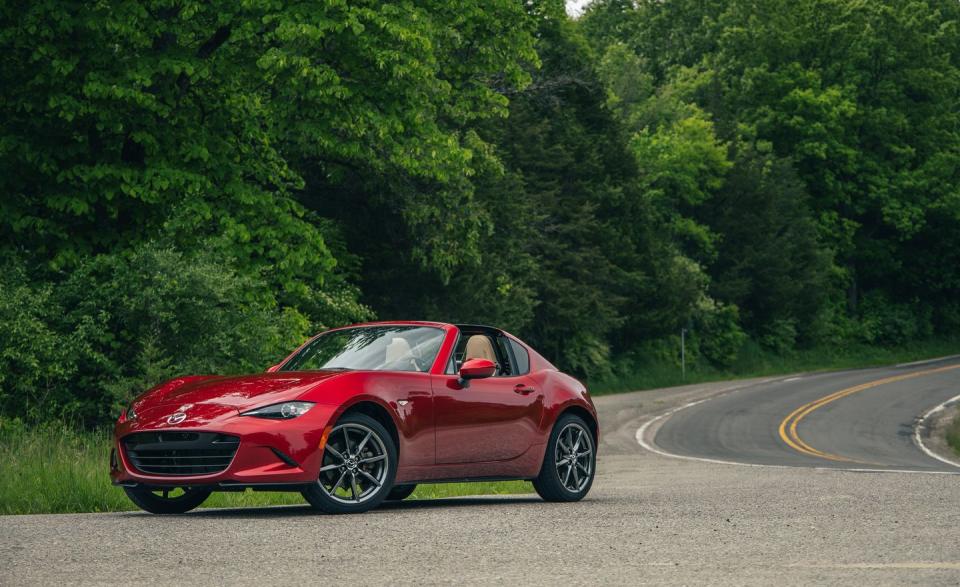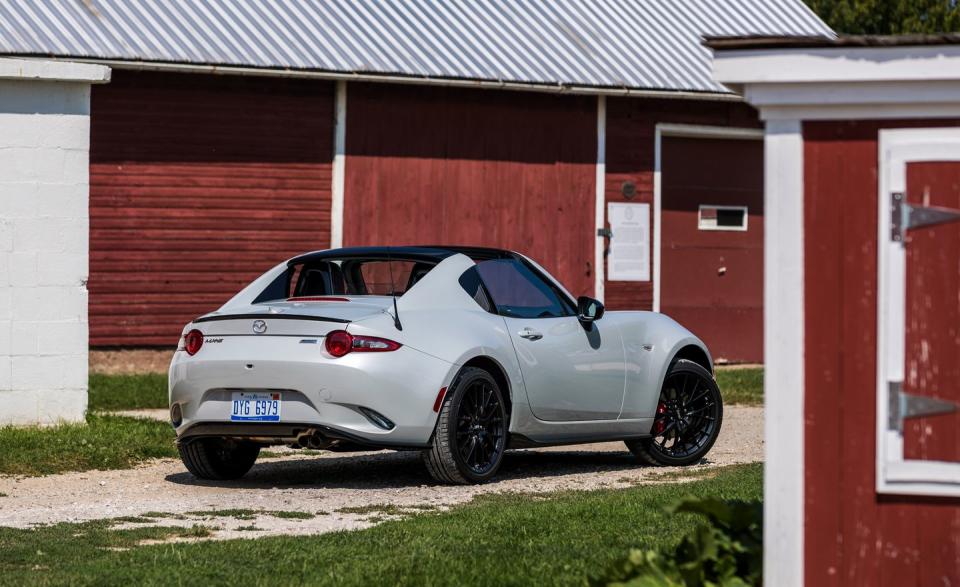The 2019 Mazda MX-5 Miata RF Is Excellent Regardless of Its Transmission

The Mazda MX-5 Miata is one of our favorite new cars on sale today and a veteran on our 10Best Cars roster. But we're fans of continuous improvement and fully support Mazda's updates to the Miata for 2019, which are highlighted by a boost in engine output from 155 to 181 horsepower. In our testing, that increase made the softtop roadster the quickest Miata we've ever reviewed since the model's introduction in 1989. So, how does the update play out for the RF model, the so-called Retractable Fastback Miata variant that trades the roadster's manual-folding soft top for a power-folding targa panel and a coupe-like roofline?
To find out, we tested a pair of 2019 RFs with the updated engine: a Club model equipped with Mazda's delightful six-speed manual transmission and a fancier Grand Touring version with the optional six-speed automatic ($600 on most trims). Our hot-take suggestion? Go ahead, equip your 2019 Mazda MX-5 Miata RF with the automatic if that's your thing. We won't judge. You're still getting an incredibly fun rear-wheel-drive sports car. But there's a bit more to it than that.

Doing the Work
Based on our test results as well as our preferences, the manual-transmission RF delivers both the quickest acceleration and the most entertainment in terms of driver engagement. Our Miata RF Club test car accelerated to 60 mph in 5.8 seconds, a 0.3-second improvement over a similar 2017 MX-5 RF we tested and a mere 0.1 second behind the quickest 2019 Miata roadster we've evaluated. That softtop car also was a Club model yet weighed about 100 pounds less than the RF.
Those uninterested in rowing their own gears and operating a third pedal, however, won't feel entirely left out of the fun. The automatic-equipped RF trailed the stick-shift model in the race from zero to 60 mph by only 0.7 second, hitting that mark in a still-quick 6.5 seconds. The automatic weighs roughly 50 pounds more than the manual. With the automatic's tendency to neuter much of the updated engine's zeal for revs, overall acceleration feels slower than the numbers suggest. In keeping with other modern automatic-transmission Mazda products, the Miata RF's unit is willing to hold gears through corners and generally resists upshifting as early as possible for the sake of efficiency. These traits are amplified by thumbing the drive-mode switch on the center console from Normal to Sport, which erases some of the slop in the feedback loop between the driver's right foot and the transmission's responses.

While Mazda provides shift paddles on the MX-5's steering wheel for changing gears, they're useful solely for quickly summoning on-demand downshifts. The paddles' responses to upshifts (as well as those initiated via the shift lever itself) are rather lackadaisical. Particularly in the RF configuration, the self-shifting Miata is an especially nifty summer-cruise option. But should you want right-now gear selection, along with the full promise of the feisty feel the Miata delivers, the six-speed stick remains the way to go.
Personal Preferences
The transmission has little effect on the rest of the MX-5 Miata's dynamic repertoire, as every variant attacks the tasks of stopping and turning with enthusiasm. We recorded the same 0.90 g of lateral grip in the Club-spec manual-transmission RF as we did with the Grand Touring automatic model. Their 70-mph-to-zero braking results told much the same story, landing within three feet of each other at 164 and 161 feet. Those figures fall on top of those we've recorded for the 2019 Miata roadster.

The Miata RF displays the same immediate steering response as its softtop siblings. It also rides firmly, particularly the Club model, thanks to its sporty suspension tune and short wheelbase. Other demerits shared with softtop Miatas are a factor of the car's diminutive size, including a lack of headroom (with the roof up) for tall drivers, minimal cubby space, and a small five-cubic-foot trunk. The new-for-2019 telescoping adjustment for the steering column (it was previously tilt only) will be greatly appreciated, however.
Although the more enclosed RF costs between $2555 and $2755 more than the roadster, depending on the model, it remains the Miata to buy for commuting duty. While the difference between our sound level measurements at 70 mph is negligible for the latest hard- and softtop MX-5s—the 76 decibels returned by the quietest RF is but 2 decibels less than several roadsters we've tested—lowering the RF's targa panel results in a turbulent swirl of air in the cockpit above 45 mph. We prefer top down in the softtop Miata. We also prefer to do our own shifting. Fortunately, however, you can't go wrong with any 2019 Miata, even one with an automatic.
You Might Also Like

